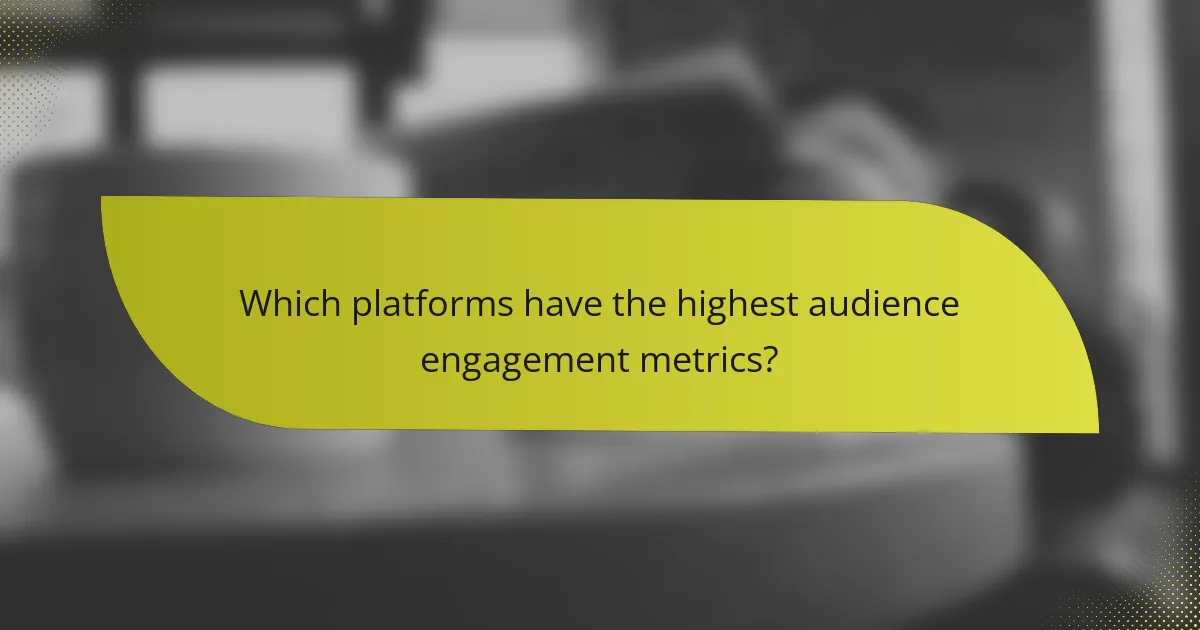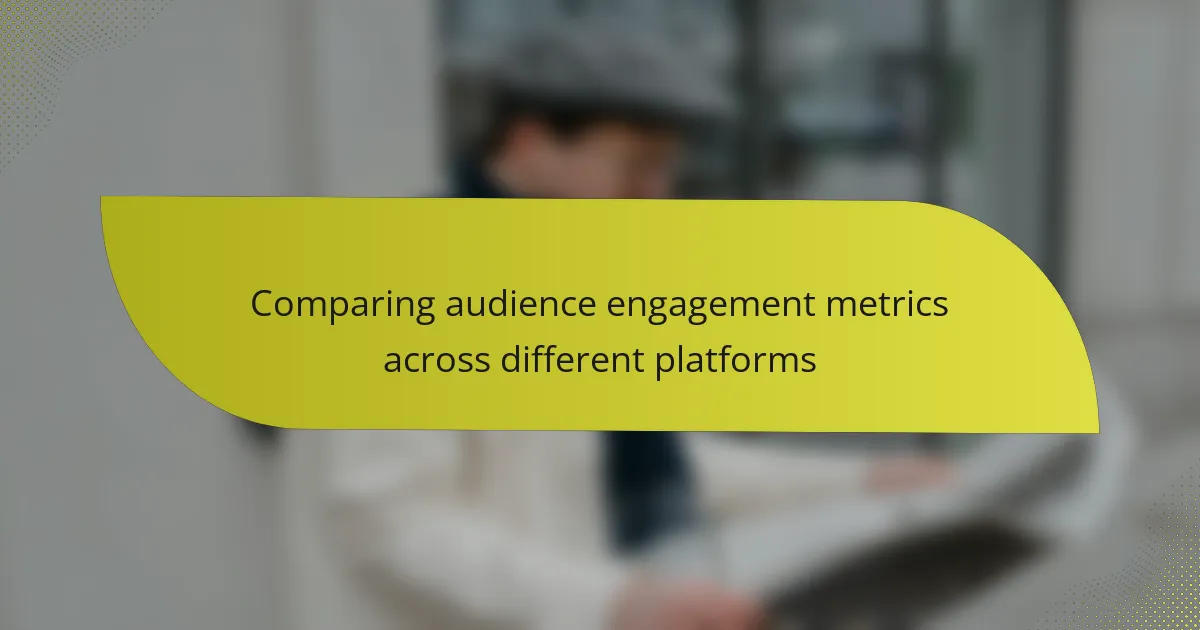In the ever-evolving landscape of social media, audience engagement metrics differ widely across platforms, with Instagram and TikTok often leading the way. These variations are shaped by factors such as content type, audience demographics, and platform algorithms, making it essential for marketers to understand each platform’s unique characteristics. By tailoring content strategies to align with user behaviors and preferences, brands can significantly enhance their engagement rates and overall effectiveness.

Which platforms have the highest audience engagement metrics?
Platforms like Instagram and TikTok typically exhibit the highest audience engagement metrics, often surpassing traditional social media channels. Engagement rates are influenced by factors such as content type, audience demographics, and platform algorithms.
Facebook engagement rates
Facebook engagement rates have seen a decline in recent years, with average rates hovering around 0.5% to 1.5%. This drop is attributed to algorithm changes that prioritize personal connections over brand content. To improve engagement, brands should focus on creating shareable content and utilizing Facebook Stories.
Instagram audience interaction
Instagram boasts some of the highest engagement rates, often ranging from 1% to 3% for posts and even higher for Stories. Visual content, such as high-quality images and videos, tends to perform best. Brands can enhance interaction by using polls, questions, and interactive stickers in their Stories.
Twitter engagement statistics
Twitter engagement rates are generally lower, averaging around 0.5% to 1%. However, tweets with images or videos can significantly increase interactions. To maximize engagement, brands should tweet consistently, use relevant hashtags, and engage with followers through replies and retweets.
YouTube viewer retention
YouTube’s viewer retention metrics are crucial for success, with ideal retention rates being above 50% for most videos. Engaging content that hooks viewers in the first few seconds can lead to higher retention. Creators should analyze audience drop-off points to refine their content strategy.
TikTok engagement trends
TikTok has rapidly become a leader in audience engagement, with rates often exceeding 5%. The platform’s algorithm favors creative and entertaining short videos, making it essential for brands to stay trendy. Utilizing popular sounds and challenges can significantly boost visibility and interaction.

How do audience engagement metrics differ by platform?
Audience engagement metrics vary significantly across platforms, reflecting different user behaviors and content consumption patterns. Understanding these differences is crucial for optimizing content strategies tailored to each platform’s unique audience.
Comparing engagement types
Engagement types can include likes, shares, comments, and time spent on content. For instance, social media platforms often prioritize likes and shares, while blogs may focus more on comments and time spent reading. Each type of engagement indicates different levels of audience interaction and interest.
When analyzing engagement, consider the context of each platform. A high number of likes on Instagram may not equate to the same level of engagement as thoughtful comments on a blog post. This distinction is vital for assessing content effectiveness.
Platform-specific metrics
Each platform has its own set of metrics that can indicate engagement levels. For example, Facebook provides insights on post reach and engagement rate, while Twitter focuses on retweets and mentions. Understanding these metrics helps tailor content to maximize audience interaction.
Instagram emphasizes visual engagement through likes and saves, while LinkedIn values professional interactions, such as shares and comments on industry-related posts. Familiarizing yourself with these platform-specific metrics can enhance your content strategy.
Content format impact
The format of content significantly affects audience engagement across platforms. Video content typically garners higher engagement rates on platforms like TikTok and YouTube, while infographics may perform better on Pinterest and LinkedIn. Adapting content formats to suit the platform can lead to improved audience interaction.
Additionally, consider the length and style of your content. Short, catchy posts work well on Twitter, while in-depth articles are more suitable for platforms like Medium or personal blogs. Tailoring your content format to the platform’s audience preferences is essential for maximizing engagement.

What are the best practices for maximizing engagement on each platform?
To maximize engagement on social media platforms, tailor your content strategies to fit the unique characteristics and audience preferences of each platform. Understanding the nuances of user behavior can significantly enhance interaction rates and overall effectiveness.
Facebook content strategies
Facebook thrives on community engagement and storytelling. Use rich media like videos and images to capture attention, and encourage discussions through polls and questions. Aim for posts that evoke emotions or provide value, such as how-to guides or informative articles.
Posting frequency matters; aim for 1-2 times per day to avoid overwhelming your audience. Utilize Facebook Insights to analyze which types of content resonate most with your followers, adjusting your strategy accordingly.
Instagram engagement tips
Instagram is visually driven, so high-quality images and videos are essential. Use Instagram Stories and Reels to share behind-the-scenes content or quick tips, which can increase visibility and interaction. Hashtags are crucial; use relevant ones to reach a broader audience while keeping them specific to your niche.
Engage with your audience through comments and direct messages. Aim to respond within a few hours to foster a sense of community. Consider hosting giveaways or collaborations with influencers to boost engagement and attract new followers.
Effective Twitter tactics
Twitter’s fast-paced environment requires concise and impactful messaging. Use threads to tell a story or provide detailed information, and leverage trending topics to join relevant conversations. Engaging visuals, such as GIFs or images, can enhance your tweets and attract more attention.
Tweet frequently, ideally several times a day, to maintain visibility. Utilize Twitter Analytics to track engagement rates and adjust your content strategy based on what resonates most with your audience.
YouTube growth techniques
YouTube relies on compelling video content and consistency. Create engaging thumbnails and titles to improve click-through rates. Focus on delivering value in your videos, whether through entertainment, education, or inspiration, to keep viewers watching until the end.
Regular uploads, such as weekly or bi-weekly, help build an audience. Encourage viewers to like, comment, and subscribe, and engage with comments to foster community. Use YouTube Analytics to refine your approach based on viewer behavior and preferences.

What criteria should be used to select the right platform for engagement?
Selecting the right platform for audience engagement hinges on understanding your target audience, the type of content you plan to share, and the advertising features available. Each platform has unique strengths that can enhance your engagement strategy based on these criteria.
Target audience demographics
Understanding the demographics of your target audience is crucial for selecting the right platform. Different platforms attract varying age groups, interests, and geographic locations. For instance, platforms like TikTok are popular among younger users, while Facebook tends to have a broader age range, including older adults.
Consider conducting surveys or using analytics tools to gather data on where your audience spends their time online. This can help you align your engagement efforts with the platforms that best reach your intended demographic.
Content type suitability
The type of content you create should influence your platform choice. Visual content, such as videos and images, performs well on platforms like Instagram and TikTok, while written content may find a better home on blogs or LinkedIn. Each platform has its strengths in terms of content format.
Evaluate your content strategy and determine which platforms support the formats you intend to use. For example, if you plan to produce long-form articles, a platform like Medium or a dedicated blog site may be more effective than a social media platform.
Advertising capabilities
Advertising capabilities vary significantly across platforms, impacting your ability to reach a wider audience. Some platforms offer advanced targeting options, allowing you to reach specific demographics based on interests, behaviors, and location. Facebook and Google Ads are known for their robust advertising tools.
When selecting a platform, assess the advertising features that align with your budget and goals. Consider factors like cost-per-click, ad formats, and analytics tools to measure your campaign’s effectiveness. This will help you maximize your engagement efforts and return on investment.

How can audience engagement metrics inform display advertising strategies?
Audience engagement metrics provide valuable insights that can enhance display advertising strategies by identifying which platforms yield the highest interaction rates. By analyzing these metrics, advertisers can make informed decisions on where to allocate their budgets for maximum impact.
Optimizing ad placements
Effective ad placements are crucial for maximizing visibility and engagement. By examining metrics such as click-through rates (CTR) and time spent on ads, advertisers can determine the most effective locations for their ads on various platforms. For instance, ads placed in the top third of a webpage typically perform better than those at the bottom.
Consider A/B testing different placements to see which generates the best results. This iterative approach allows for continuous improvement based on real-time data.
Tailoring content for platforms
Each platform has its unique audience and content preferences, making it essential to tailor advertising content accordingly. For example, visuals and messaging that resonate on Instagram may not be as effective on LinkedIn. Understanding audience demographics and engagement patterns can guide the creation of platform-specific content.
Utilize insights from engagement metrics to adjust tone, style, and format. Short, eye-catching videos may work well on social media, while detailed infographics might be more suitable for professional networks.
Measuring ad performance
Regularly measuring ad performance is vital for refining advertising strategies. Key performance indicators (KPIs) such as conversion rates, impressions, and engagement levels should be tracked consistently. This data helps identify which ads are performing well and which need adjustments.
Establish a clear reporting framework to analyze these metrics over time. Use tools that allow for easy comparison across platforms, ensuring that you can make data-driven decisions to enhance overall campaign effectiveness.
